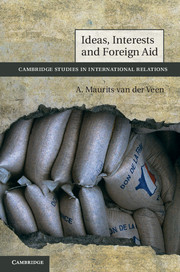Book contents
- Frontmatter
- Contents
- Figures
- Tables
- Preface
- 1 The many uses of foreign aid
- 2 One policy, multiple goals
- 3 Debates about aid
- 4 Aid frames
- 5 The administration of aid policy
- 6 The generosity contest
- 7 The popularity contest
- 8 Conclusion
- Appendix A Legislative debates coded
- Appendix B Debate coding examples
- Appendix C Aid distribution: data and sources
- Bibliography
- Index
Appendix C - Aid distribution: data and sources
Published online by Cambridge University Press: 07 September 2011
- Frontmatter
- Contents
- Figures
- Tables
- Preface
- 1 The many uses of foreign aid
- 2 One policy, multiple goals
- 3 Debates about aid
- 4 Aid frames
- 5 The administration of aid policy
- 6 The generosity contest
- 7 The popularity contest
- 8 Conclusion
- Appendix A Legislative debates coded
- Appendix B Debate coding examples
- Appendix C Aid distribution: data and sources
- Bibliography
- Index
Summary
Data for the dependent variable was derived from the aid database of the OECD’s Development Assistance Committee (DAC), both in CD-ROM format and online (www.oecd.org/dac). As discussed in Chapter 7, the aid measure selected was net disbursements. Occasionally countries repay earlier development loans, which makes it appear as though they receive negative aid. However, we are concerned with a recipient’s share of a donor’s total aid in a given year. Since negative aid is equivalent to a zero share, negative values are truncated to 0. For every recipient-year, I calculated the aid share of that recipient from each of our four case study countries, as well as its aid share from the DAC as a whole. Often, a few countries get most of the aid, while a much larger number gets comparatively little. In order to generate a more meaningful ranking, therefore, I take the log of these aid shares.
Data for the independent variables was drawn from a number of different databases. Basic country indicators – GDP, area and population, as well as literacy, life expectancy and mortality rates – are from the World Bank’s World Development Indicators CD-ROM (2004 edition). Trade data were taken from Gleditsch’s trade and GDP dataset. Data on political similarity is provided by Gartzke’s Affinity of Nations dataset, which provides an indicator of voting agreement at the United Nations. Data on the quality of democracy (or autocracy) in a country were taken from the Polity IV dataset, and information about political and civil rights came from the Freedom House dataset.
- Type
- Chapter
- Information
- Ideas, Interests and Foreign Aid , pp. 259 - 263Publisher: Cambridge University PressPrint publication year: 2011

